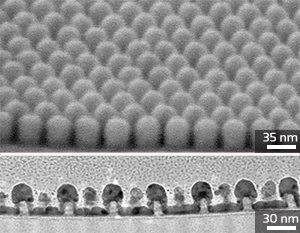

| Visitors Now: | |
| Total Visits: | |
| Total Stories: |

| Story Views | |
| Now: | |
| Last Hour: | |
| Last 24 Hours: | |
| Total: | |
Computer Memory With 3.3 Terabits Per Square Inch
From NextBigFuture.com
There are two common approaches to increasing the recording density of granular media: one is to reduce the grain size and the other is to reduce the number of grains per bit. Unfortunately, the general consensus is that both approaches will have difficulty pushing beyond the one terabit per square inch limit.
Researchers have now come up with an alternative approach using so-called bit-patterned media (BPM). In contrast to granular media, BPM consists of ordered arrays of individual 'superbits' (see image) that are larger than the grains in granular media and can be individually addressed on a disk platter to improve signal-to-noise ratio. However, the fabrication of BPM requires lithographic patterning, a costly process that necessitates substantive viability studies to meet commercial requirements. Yang and his team have now demonstrated the fabrication of BPM with densities as high as 3.3 terabits per square inch — or 15 nanometer pitch — using a method that does not require pattern transfer processes such as etching and liftoff, which typically reduce pattern fidelity.
Tilted-view scanning electron microscope (top) and cross-sectional transmission electron microscope (bottom) images of high-density bit-patterned media consisting of magnetic cobalt–palladium bits formed on hydrogen silsequioxane nanoposts defined by electron beam lithography.© 2011 IOP
Nanotechnology journal – Fabrication and characterization of bit-patterned media beyond 1.5 Tbit/in²
The new fabrication process involves only two steps. The first step involves the use of electron-beam lithography on hydrogen silsesquioxane resist to define silicon oxide nanoposts. “The resolution of our technique is higher than most electron beam lithography processes because we use a salt solution and development process that result in closely-spaced nanopost-resist structures down to a 15 nanometer density,” says Yang.
The second step involves the deposition of cobalt–palladium films on top of the nanoposts to forming isolated magnetic bits (see image). “Because the nanopost resist is made of robust silicon oxide material, we can avoid the etching step by depositing magnetic material directly onto these nanostructures to form the magnetic bits,” explains Yang.
The researchers used magnetic force microscopy (MFM) to analyze their BPM and found that the magnetic bits are magnetically isolated, thus able to store single bits of information, down to the best MFM-resolution of 20 nanometers. Yang and his team believe that the magnetic bits would remain isolated and individually controllable up to 3.3 terabits per square inch.
We fabricated bit-patterned media (BPM) at densities as high as 3.3 Tbit/in² using a process consisting of high-resolution electron-beam lithography followed directly by magnetic film deposition. By avoiding pattern transfer processes such as etching and liftoff that inherently reduce pattern fidelity, the resolution of the final pattern was kept close to that of the lithographic step. Magnetic force microscopy (MFM) showed magnetic isolation of the patterned bits at 1.9 Tbit/in², which was close to the resolution limit of the MFM. The method presented will enable studies on magnetic bits packed at ultra-high densities, and can be combined with other scalable patterning methods such as templated self-assembly and nanoimprint lithography for high-volume manufacturing.
If you liked this article, please give it a quick review on ycombinator or StumbleUpon. Thanks
See more and subscribe to NextBigFuture at NextBigFuture.com
Source:



